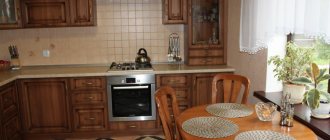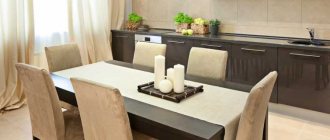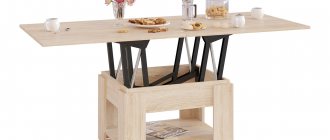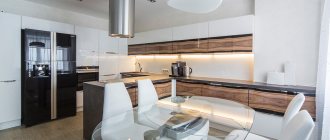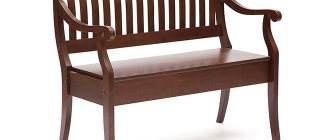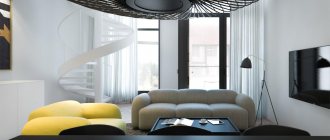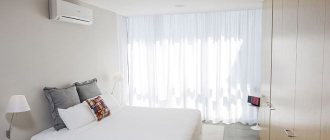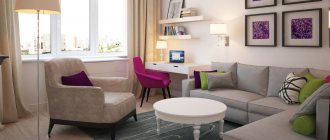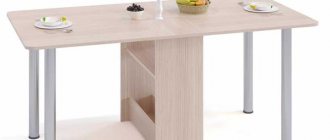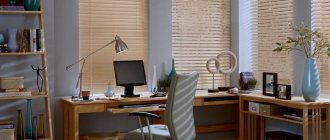Benefits of using stone
By choosing stone (artificial or natural) as a finishing material, the owner gains a huge number of advantages in the kitchen:
- The surface of the stone is resistant to moisture, synthetic detergents, and abrasives. It is quite easy for kitchen owners to carry out routine wet cleaning of the room, removing dirt, soot, and greasy deposits.
- The rocky coating is absolutely not afraid of temperature changes, and therefore can be used to finish a kitchen apron. Such a decorative coating will successfully protect the underlying wall from greasy drops from the hob.
- Stone, both artificial and natural, looks great in any kitchen interior (Loft, Baroque, art decor).
- This material is absolutely safe for humans.
- Another advantage of practical use is the ease of finishing the kitchen with stone (laying stone slabs and sheet stones does not require special skills).
The list of the most important advantages can be supplemented by the presence of a large number of detailed instructions for beginners or inexperienced craftsmen.
There is always the opportunity to take advantage of video tutorials on finishing a kitchen with decorative stone from leading construction specialists and ready-made projects for interior finishing of the kitchen area.
Disadvantages of using stone
Unfortunately, among the advantages of a practical choice of material, there are always disadvantages. In this case, they include:
- Cost of decorative stone. Some types of finishing materials have a fairly high price per square meter.
- The need to prepare the underlying surface: leveling the walls, priming, coating the walls with an antiseptic, moisture-resistant compounds and antifungal drugs. Stone slabs do not allow air to pass through, and therefore there is always a high risk of developing pathogenic fungus.
- Some types of stone are quite heavy, which limits the possibility of their use (for example, for unstable, thin walls).
- The choice between artificial and natural stone is always difficult. Each option has a range of pros and cons. You have to decide which stone is best for the kitchen first, before purchasing finishing materials.
The stone is ideal for those owners who plan to carry out their next renovation no earlier than several years. After all, dismantling the coating is quite complicated and can cause certain difficulties for craftsmen.
Varieties by type of assembly
Hospitable people have long appreciated the advantages of sliding-type models. A folding kitchen table with a stone top will fit in a kitchen of any size. If the size of the room allows, you can opt for a large folding model.
These options are perfect for interiors in a modern, loft, Scandinavian or Art Nouveau style.
Additional Information. An extendable stone table for the kitchen takes up a lot of space only when unfolded. This design is ideal for a large and spacious dining room.
Folding options are no less convenient and ergonomic solution than sliding models. But such a transforming table must have simple and reliable operating mechanisms, as well as fastening mechanisms, if necessary. Oval models of folding tables, which have only one support, are very popular, as they combine practicality and design.
The model must be designed for continuous use, both folded and unfolded.
The book table is also an excellent folding version of the transformable table. Can be used both folded and unfolded.
The surface of such a countertop will be more pleasant to the touch.
Note! A table with one leg looks very stylish. The size of this piece of furniture is often small and is ideal for a small kitchen.
Areas of application of stone
Decorative stone coating can be used in a wide variety of areas in the kitchen area. These may be the following options:
- Flooring design.
- Interior finishing of wall panels.
- Installation of an original arch in combined kitchens or when zoning a room.
- Design of interesting tabletops for dining tables, work areas, original cabinets, bar counters.
- Beautiful stonework located above the bar counter. A stone canvas made of decorative material allows you to advantageously focus attention on the interior details.
- A beautiful and practical kitchen apron made of stone, which is a universal protective panel against dirt, grease, and soot.
- Stone sinks built into the worktop.
It could also be a small shelf made of marble, granite or other artificial stone, or an original panel on the wall.
Stone is used in a variety of design directions: Loft, high-tech, and even Baroque. The combination of stone slabs and a variety of interesting lamps is always an example of beauty and gloss in the interior.
Combination of stone with other finishing options
The assumption that stone texture is difficult to combine with other finishing options is nothing more than a misconception. Marble, granite, brickwork are ideally combined not only with wallpaper.
Decorative stone with wallpaper
Since the kitchen space is usually quite small, to avoid the “dungeon” effect, allocate a minimum area to the mineral. Work area or countertops – it doesn’t matter. The main thing is to play on contrasts when combining with wallpaper: if the texture of the mineral is dark, it is advisable to select wallpaper in light colors. Ideally, wallpaper should be plain or imitate natural materials.
When combining with wallpaper, it is important to take into account the rigidity of the decorative part of the wall: plaster imitation is much easier to cut to the desired shape. And when working with acrylic or colored concrete, you should attach them to the wall last.
Decorative stone with photo wallpaper
The combination allows you to show maximum creativity and create a “destroyed wall” effect. Decorate not only the apron with colored brick or agglomerate, but also the wall opposite. And on the very opposite wall, insert any picture you like on the photo wallpaper. Not only will it all look simply amazing, but there will also be an effect of expanding the space.
Stone wall with paint
Painted walls will help remove the visual congestion of the space, and masonry will allow you to place accents where they are needed. The main rule is not to use paint that matches the stone.
With plaster
One of the most winning options. With this approach, the kitchen design will not only be creative and unique, but also environmentally friendly. Venetian, also known as decorative plaster, will give the walls a stone-like appearance, creating a common, complete tandem of textures.
In this case, it is important not to visually overload the walls - no matter what the decorative stone is, the color of the finishing layer of mortar should be soft and not irritating to the eye. The same approach will help to visually expand the walls of the kitchen space.
Original arches in the kitchen
Combined kitchens are not uncommon today. Also, quite often there are kitchens with zoning of the area into a dining room and a work section. This issue is especially relevant for owners of small studio apartments or one-room apartments, where every available meter in the room is important.
Arches allow you to give your kitchen a special style and decor. This is an original combination of compact minimalism and interesting art decor. It is not at all necessary to invite a specialist, because even an inexperienced owner can handle the repair work.
Stone countertops in the kitchen
A huge selection of stone tables for the kitchen can be found today in furniture stores. These include massive models, finished in an antique style, and miniature versions in a set with chairs. Tabletops made of stone can have a solid metal base (for example, chrome-plated steel) or can be placed on a stone cabinet.
Also very popular are countertops made from broken marble chips with the addition of coloring pigments. Such tables are a great way to highlight absolutely any interior style.
Stone countertops create a unique atmosphere, comfort and design in the kitchen and dining area. In addition, they have maximum strength, resistance to moisture and detergents, and durability of use.
Note!
Designer kitchens 2020: original and exclusive options. TOP 150 photos of finished design projects
Roman blinds for the kitchen - how to choose the best option for the kitchen? Real examples, photos, new items, colors + installation instructions
- Short curtains for the kitchen - 120 photos of new designs. Review of original and beautiful combination options in the kitchen interior
Photo gallery of artificial stone kitchen countertops
Products made from acrylic or agglomerate look expressive and give the room exclusivity, a feeling of coziness and comfort. The advantages of external characteristics are complemented by the practicality, hygiene and safety of this material.
Stonework above the bar
It is not at all necessary to completely decorate the wall panels with stone. Sometimes it is enough to highlight only one part of the wall, for example, above the bar counter. This approach gives the kitchen a special style, combining notes of antiquity and classicism. Along the contour of the masonry, you can place rails and hooks for dishes, lighting fixtures and storage systems.
Finishing a kitchen apron with stone
Another example of the practical use of stonework is the design of a kitchen apron made of stone. Stone, especially natural stone, is excellent for finishing a protective sheet.
The material is durable, has a pleasant and very original design, and is resistant to moisture, temperature changes and aggressive detergent components. Just like a classic tiled splashback, this covering can be supplemented with lighting fixtures, storage systems, and decorative elements.
Types of wall edges (plinth)
| Add-on plinth with upper curve Rв, edge to the rear of the tabletop h | |||
| Rв, mm | h, mm | ||
| 3, 6, 8 | 20-40 | ||
| Monolithic plinth with upper rounding Rв and lower rounding (mating with the product) Rн, side to the rear of the tabletop, height h | |||
| Rв, Rн, mm | h, mm | ||
| 3, 6, 8 | 20-40 | ||
The cost of manufacturing stone tables and countertops is calculated individually for a specific sketch. Find out the cost of your product and its production time from our managers by phone: 8 or send us a request:
Stone sinks in the kitchen
Modern interior styles dictate certain rules for choosing furniture, including for the kitchen area. For example, furniture should be practical and have proper functionality.
The combination of style, practicality, ease of maintenance and a certain gloss is carried by a stone sink. They can be made from both natural and artificial stone. However, preference is given to natural materials due to their special strength and resistance to abrasive cleaning agents.
Such furniture is absolutely not afraid of water and can be built into a work panel in close proximity to the hob.
Material samples
We can also offer a wide range of shades of granules from the Natural and Sonata collections. The cost of a coating interspersed with these collections is from 4,000 rubles.
Collection "Natural"
Collection “Natural”, shade 001
Collection “Natural”, shade 002
Collection “Natural”, shade 003
Collection “Natural”, shade 004 Collection “Natural”, shade 005
Collection “Natural”, shade 006
Collection “Natural”, shade 007
Collection “Natural”, shade 008
Collection “Natural”, shade 009
Collection “Natural”, shade 010 Collection “Natural”, shade 011
Collection “Natural”, shade 012 Collection “Natural”, shade 013
Collection “Natural”, shade 014 Collection “Natural”, shade 015
Collection “Natural”, shade 016 Collection “Natural”, shade 017
Collection “Natural”, shade 019
Collection “Natural”, shade 020 Collection “Natural”, shade 021 Collection “Natural”, shade 022 Collection “Natural”, shade 023 Collection “Natural”, shade 024
Collection “Natural”, shade 025
Collection “Natural”, shade 026 Collection “Natural”, shade 027
Collection “Natural”, shade 028
Collection “Natural”, shade 029
Collection “Natural”, shade 030
Collection "Sonata"
Collection “Sonata” - shade “Refined”
Collection “Sonata” - shade “Artkika”
Collection “Sonata” - shade “Lyra”
Collection "Sonata" - shade "Waltz" Collection "Sonata" - shade "Lady" Collection "Sonata" - shade "Blonde"
Collection "Sonata" - shade "Pralins" Collection "Sonata" - shade "Satin" Collection "Sonata" - shade "Andrew"
Collection “Sonata” – shade “Lukum” Collection “Sonata” – shade “Havana”
Collection "Sonata" - shade "Papyrus" Collection "Sonata" - shade "Solo" Collection "Sonata" - shade "Delhi" Collection "Sonata" - shade "Latte"
Collection “Sonata” – shade “Punch” Collection “Sonata” – shade “Flamingo”
Collection “Sonata” - shade “Caprice”
Collection "Sonata" - shade "Madagascar" Collection "Sonata" - shade "Carpaccio" Collection "Sonata" - shade "Sheikh"
Collection “Sonata” - shade “Step”
Collection “Sonata” – shade “Canyon” Collection “Sonata” – shade “Aquamarine”
Collection “Sonata” – shade “Mojito” Collection “Sonata” – shade “Flora”
Collection "Sonata" - shade "Tarragon" Collection "Sonata" - shade "Flint" Collection "Sonata" - shade "Aqua" Collection "Sonata" - shade "Avenue" Collection "Sonata" - shade "Marcus"
Collection “Sonata” - shade “Leon”
Collection “Sonata” - shade “Viola”
Collection “Sonata” - shade “Grad”
The colors presented in the table are basic, the rest are available by agreement.
We can also offer you coatings with stains “like natural marble”. Samples of materials are presented in the gallery below. The cost of coverage is from 9,500 rubles.
A countertop or kitchen table made of artificial stone is a luxury that is available to everyone today! Such products look as chic and high-quality as work made from natural stone, and their cost is much lower:
The cost of manufacturing stone tables and countertops is calculated individually for a specific sketch. Find out the cost of your product and the timing of its production from our managers by phone: 8
or send us a request:
Features of material care
Natural facing stone has the least practical maintenance requirements. This coating is quite easy to wash and remove dirt with a brush and detergents. Particular attention should be paid to joints and nicks, where greasy deposits, soot, and dirt can accumulate.
Regarding artificial finishing material, there are a number of care features:
- Before purchasing a stone, you should carefully study the composition and presence of a protective coating (varnish).
- If there is no industrial impregnation of synthetic stone, you must do it yourself, using acrylic varnish or specialized compounds.
Otherwise, the secrets of caring for finishing materials are as simple as in the case of natural stone.
Recommendations for choosing and caring for countertops
Caring for a countertop made of cast stone is not demanding. In order to remove dirt, you will need to use a microfiber cloth. This cloth should be soaked in warm tap liquid and used to clean the work surface. There is an important rule that must be followed - under no circumstances should you use abrasive preparations. These products may harm the polish.
Sharp objects on stone countertops should be used with great care.
It’s easy to give a new look to an interior item; sandpaper and polish are used for this. To remove deep damage, you need to use the services of a specialist who can spray the substance onto the defective area and then polish the uneven areas.
Manufacturers recommend using cutting boards and trivets for hot dishes. Try not to drop heavy or cutting objects, and then the tabletop made of molded material will last for many years.
Types of natural stone for renovation
Natural material is quite expensive, however, it is more unpretentious and durable in practical use. Colors and rainbow shades created by nature give surfaces a special gloss and style, and the room a pleasant decor.
There are several types of natural stone that can be found on the shelves of a building supply store today:
Marble. Marble slabs are used for repairs in almost all areas of the house and apartment. Decorating the kitchen and dining area with marble occupies a leading place among designers. In practice, you can find massive, incredibly beautiful marble countertops that shimmer with mother-of-pearl shades. These can be slabs for finishing work panels and kitchen aprons.
Granite is a material that is in no way inferior in popularity to a finishing material. This rock has even greater strength and is particularly resistant to abrasion, deformation, damage and abrasive cleaning agents.
Dolomite and slate. These breeds are perfect for cladding wall panels in the kitchen and dining area. They have an incomparable design and pleasant (not irritating to the viewer's eye) colors. The list of positive qualities is complemented by special durability and strength. Even an inexperienced craftsman can install stone panels on walls using step-by-step instructions and video recommendations for the work being carried out.
Sandstone and onyx are perfect for finishing artificial stoves and bar counters; they have a rich sandy tint, beautiful iridescent colors on the surface and a glossy sheen (for onyx, gloss is characteristic of nature; for sandstone, shine is imparted under industrial conditions).
It is up to the owner to decide which stone is best for the kitchen. And the choice will depend on the area of the room, the availability of lighting, and household features.
Do-it-yourself liquid stone tabletop
So, you can make a tabletop from liquid stone with your own hands.
Repair work begins with the preparation of tools.
To work you will need:
- electric drill with a mixer attachment or jigsaw;
- compressor;
- spray gun and screwdriver;
- grinder and router;
- heat gun.
Then prepare the materials:
- waterproof plywood for the base;
- plasticine and fiberglass;
- chemical resin;
- colors, acetone and hardener;
- hot melt adhesive, calcite and gelcoat.
Having prepared the tools and materials, you can begin to work. To create a high-quality countertop, it is important to do everything without haste and follow the step-by-step instructions:
- A chipboard mold is prepared at the workplace. It is secured along the edge and cut to the previously left 5 mm on each side.
- The end of the furniture is covered with plasticine to give it a shaped shape using a router. The internal parts of the matrix are coated with wax mastic to create an insulating layer.
- After 15 minutes, three layers of acrylic without dye are applied using a sprayer. It is important to apply subsequent layers only after the previous one has dried. The work is carried out carefully, since the appearance of the edge of the product depends on this.
- Then the preparation of the main mixture begins. Mix three parts acrylic, one part mineral chips and dye. Pre-wash and dry the mineral chips.
- The resulting composition is applied with a brush to the inner surface of the mold. It is important to apply the mixture evenly and in several layers.
- After drying, the reinforcement stage begins. Fiberglass cloth is placed in the mold and pressed down. Glue mixed with a hardener is applied on top of it. A pre-prepared chipboard form is inserted, and a load is placed on top.
- The last layer of glue is poured in a mixture with a hardener and after 4 hours the chipboard blank is removed, and the product is polished and decorated.
This is interesting:
White kitchen design with black countertops.
Gluing an edge to a tabletop with your own hands at home.
DIY Kitchen Countertop Update.
Types of artificial stone for renovation
Much cheaper options for finishing materials are artificial stone. It is made from three bases: acrylic, gypsum and porcelain stoneware. As additional admixtures, stone chips from natural stone, pigment dyes and fillers (for example, epoxy resin) are used. Thanks to the use of various production technologies, today you can find materials of a wide variety of shapes, textures, and sizes.
Instability to moisture is successfully compensated for by additional coatings with varnish, paint, and other decorative compounds. In addition to cost, such materials are lighter in weight, which significantly expands the scope of application (decorative partitions for zoning a room, original panels on the walls).
Artificial and liquid stone: what's what
When choosing countertops for a kitchen or bathroom, buyers are often faced with the problem of which material to choose, and here the cost of the product plays a big role. Manufacturers offer traditional countertops made of chipboard, countertops made of natural and artificial stone.
When choosing a countertop made of artificial stone, consumers may be misled due to their ignorance. The fact is that artificial stone, along with sheet acrylic stone, is often called products made from cast stone, called “liquid”, which at first glance, although similar to sheet stone, has a number of significant differences, which we will discuss in this article.
Artificial, or acrylic stone, is a product produced using the technology of polymerization of purified acrylic resin with a mineral filler. The process of mixing ingredients takes place in specialized industrial-type mixers equipped with automated quality systems that allow you to control the accuracy of the dosage of components and ensure full compliance of the color of the finished product with the previously selected sample.
Vacuum pumps are connected to the mixer design, creating an airless space in the mixing containers, which guarantees one hundred percent uniformity of the material over its entire area. The material is produced in sheets, the weight of 1 m² of material is 22 kg.
Sheet artificial stone has hygienic certificates and permits for contact with food products.
The complex manufacturing process results in a solid, non-porous material that can be easily worked with, i.e. it can be cut, drilled, sanded, glued and repaired if necessary.
Artificial sheet stone is a homogeneous material supplied to manufacturers in the form of plates measuring 3660 mm x 760 mm and 12.5 mm thick. Next, the material is cut into the required elements and a tabletop structure is created using special glue.
In order to connect the kitchen countertop with furniture cabinets, a frame made of moisture-resistant plywood is mounted inside the structure, which allows you to fasten the kitchen cabinets to the tabletop anywhere. The frame itself does not affect the strength of the product, since the stone can withstand a load of up to 50 kg per m².
In addition, sheet artificial stone has a very rich palette of shades and a huge number of variations depending on the size of the grains of inclusions (from the smallest to 5-6 mm in diameter), as well as inclusions imitating granite. Therefore, artificial sheet stone can be difficult to distinguish from natural natural stone.
In addition, it has a number of undeniable advantages compared to natural stone:
- the seams on the product at the junction of the elements are absolutely invisible, which is impossible to achieve when making a product from natural stone;
- manufacturing a cast sink that is integrated with the countertop, which is also impossible in the case of natural stone;
- a countertop made of artificial sheet stone weighs several times less than a similar one made of natural stone, which means that the manufacture of special, especially durable, expensive furniture cabinets is not required;
- unlimited possibilities for bringing design ideas to life: combining a tabletop with a window sill, sidewalls, a bar counter, manufacturing a product of any shape with smooth, seamless transitions.
Manufacturers of products made from poured (“liquid”) stone position them as an environmentally friendly material that can be installed even in kindergartens. They claim that artificial sheet and “liquid stone” are made from the same material.
Expert opinion
Romanova Ksenia Petrovna
Interior design expert and fabric store manager
In reality, gelcoat, polyester resin and fillers are used to produce liquid stone. In order to reduce the shrinkage of the polyester resin, a rather expensive filler must be used - aluminum hydroxide.
However, to reduce the cost of the production process, it is replaced with calcite, which costs several times less. The chemical solvent of gelcoat and polyester resin is styrene (a toxic volatile substance with hepatotoxicity.
Routes of entry into the body: respiratory system, mucous membranes and skin, digestive tract).
To polymerize the material, peroxide (butanox) is used, which reacts with polyester. Styrene, on the other hand, does not enter into any reaction, but, on the contrary, is released - evaporates.
The final evaporation time of styrene from 5 mm thick polymerized polyester resin is up to 1.5 years. The evaporation process can be accelerated by using special thermal chambers (oven with t=850°C, relative humidity 40-50%, vacuum of at least 0.4 Pa and CO² supply.
Heating cycle is at least 8 hours). Only in this case can we talk about removing 50% of styrene from the product, and the remaining 50% will evaporate for another 5-6 years.
Thus, products made from cast stone can only be used in non-residential ventilated areas.
The technology for manufacturing a product from “liquid” stone is as follows: on a base made of chipboard (usually not moisture-resistant to reduce the cost of the product), a thin layer (up to 3 mm) of the “liquid stone” composition is sprayed (since the products are all individual, they are not produced in a factory, but in a makeshift way, practically “on your knees.” Here, not only is ultraviolet equipment and thermal chambers not used, but often the post-curing time of the material is not even maintained (at least 14 days), so the final curing of the polymer occurs on site.
“Liquid stone” is a material produced on the basis of a mixture of gelcoat and polyester resin with a mineral filler, the dimensions of which are limited by the diameter of the spray gun nozzle and cannot exceed 1-2 mm, otherwise the surface of the product will not look uniform (with bald spots), but the total thickness of the applied layer does not exceed 1.5-3 mm. That is, in its essence, “liquid stone” is paint applied to the base and creating the illusion of a strong and durable material, and the strength of such a product directly depends on the strength of the chipboard, which is the basis of the countertop.
In addition, the resins that make up the “liquid stone” do not have the necessary degree of adhesion to the surface and it often happens that in some places the “liquid stone” peels off and bubbles appear. Such products last from several months to a couple of years, then they are completely destroyed (they crack due to the swelling of the chipboard, often in the area of the sink and hob).
Unlike sheet acrylic stone, “liquid” does not have so many shades or large inclusions. When you tap on such products, you feel a thin layer of stone and a thick layer of chipboard (dull sound).
It has a matte surface, as it cannot be sanded to a mirror-glossy surface due to its loose structure. stone is based on the ability to spray patterns onto the surface, greater resistance to thermal influences and a price that is 30-50% lower compared to artificial sheet stone.
However, whether the small difference in price is worth the significant difference in quality is up to everyone to decide for themselves.
